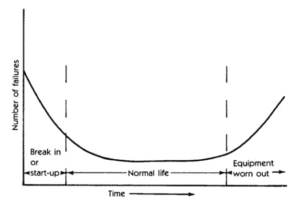Airlines spend a substantial portion of their total operating costs on maintenance, repair and overhaul (MRO).
Global aviation is expected by the International Air Transport Association[1] (IATA) to double over the next 20 years.
With that, MRO costs will also continue to rise.
Airlines face a real challenge to reduce MRO costs and improve operational efficiency.
Predictive maintenance, so-called predictive maintenance, makes it possible to reduce MRO costs and increase operational efficiency through sensor technology and artificial intelligence.
Through predictive maintenance, the remaining life of equipment can be maximized by performing maintenance and overhaul at the right time and avoiding costly repairs.
Introduction
It has been music to the ears of many organizations for years; reduced MRO costs and increased profitability through intelligent maintenance techniques.
The idea of predictive maintenance is quite simple, namely, the timely maintenance of machines through sensor data and artificial intelligence in order to reduce MRO costs and unplanned downtime.
Until recently, the algorithms that enable predictive maintenance were either undeveloped, not at an advanced stage or too costly to apply.
In recent years, however, the computing power of computers has increased substantially, developments in artificial intelligence are rapidly following one another, and sensors have become even more accurate and cheaper.
This lowers the originally high investment threshold and makes it more accessible and attractive to more and more organizations.
In particular, the energy, transportation, manufacturing and information technology sectors are leaders in predictive maintenance.
This comes as no surprise, especially to aviation.
An annual report by IATA’s Maintenance Cost Technical Group shows that in 2018, airlines worldwide collectively spent $69 billion[2] on MRO, representing approx.
9% of their operating costs.
Logically, airlines are trying to reduce MRO costs with state-of-the-art predictive maintenance algorithms.
Dutch aviation is busy doing this; you can read in KLM’s most recent annual report[3] that the biggest decrease in their MRO costs was achieved through predictive maintenance.
In the manufacturing sector, MRO costs are even much higher[4] and can reach between 15-60% of operational costs depending on the type of industry.
It is therefore critical for these organizations that MRO is optimized.
Maintenance techniques
There are several philosophies for performing inspections and maintenance on equipment.
These can generally be categorized under the headings of reactive, preventive and predictive.
The main difference is in the use of equipment life cycles, a typical progression of which is shown in the figure below.
This meant that equipment was repaired only when a failure occurred.
The disadvantage of this philosophy is that it involves high costs and risks; namely, one does not know when a machine will fail and how extensive the damage will be.
In the case of a machine that will not be in use for the next few days (e.g., due to the weekend) and can be repaired in time, the financial damage will be limited.
But if it is a production machine from a car factory where a car is produced every minute, or an aircraft engine from an airplane flying at the end of the troposphere, the financial and/or societal consequences are considerable.Nowadays, much of the maintenance is preventive, with inspections and maintenance being performed periodically.
With preventive maintenance, you avoid surprises that involve high costs and risks.
However, even this methodology is not optimal from a cost perspective; after all, parts or machines are inspected or maintained that are not at the end of their useful life.
In this way, the remaining and useful life of parts and equipment is not fully utilized.
And that results in unnecessary costs.By inspecting and maintaining parts and equipment at the right time, you avoid unnecessary costs and risks.
This can be done through predictive maintenance, or predictive maintenance.
With predictive maintenance, maintenance is tailored to the actual condition of the parts and machines.
What is predictive maintenance?
Predictive maintenance is a predictive maintenance methodology where the goal is to detect failure mechanisms of machines at the right time and prevent further degradation through inspections and maintenance.
The detection of failure mechanisms is done by intelligent algorithms that make predictions about the current state or remaining life of machines based on sensor data.
The sensors measure such things as vibration, temperature, noise, lubricant composition, machine performance and many other operational characteristics.
The intelligent algorithms are complex mathematical formulas whose parameters continuously adapt to new sensor data and correctness of predictions.
As a result, predictions about the actual state of the machines can be very accurate given that sufficient qualitative data is available.
There are two ways to predict maintenance.
The first possibility is to calculate the probability that parts or machines will fail in a given upcoming time period.
The second option is to predict the time when parts will fail.
The first option provides information about the current state of the parts and machinery, and therefore indirectly about the remaining life, while the latter option directly determines the remaining life.
To apply predictive maintenance, a lot of qualitative data is needed and machines must be equipped with sensors.
As a result, the initial investments are relatively high.
In most cases, however, organizations already have extensive historical data to drive and manage their processes.
This is valuable data that can be used to discover the potential of predictive maintenance for specific applications.
The initial investment may be relatively high, but the benefits are even greater.
A study[5] by the U.S. Department of Energy shows that a functional predictive maintenance program can reduce maintenance costs by 30%, reduce downtime by 45% and eliminate failures by as much as 75%.
The pros and cons.
It is now well established that predictive maintenance offers numerous benefits, mainly in the areas of cost savings and risk management.
The benefits of applying intelligent algorithms for predictive maintenance can be summarized as:
- Longer operational life of parts and machinery
- Reduced energy, labor, maintenance and parts costs
- Reduction of unexpected (catastrophic) downtime of parts and machinery
- Better service and product quality
- Increased worker and environmental safety
- Less maintenance equipment needed
Thus, applying predictive maintenance results in increased operational efficiency through lower costs, higher quality, reduced risks and more sustainable policies.
However, there are also disadvantages, and these can be summarized as:
- Savings potential often not known to management
- High investment threshold
- Higher training costs for clerical staff
Example of a prediction model.
In this section, the accuracy of predictive maintenance models will be demonstrated using a scientific paper[6] published at the International Conference on Circuits and Systems.
In this paper, predictive maintenance algorithms are applied to predict the remaining number of flights, called the Remaining-Useful-Lifetime (RUL), of aircraft engines from sensor data.
This uses NASA’s Turbofan Degradation Simulation dataset.
This is a 4-part dataset which consists of time series of 3 operational settings and 21 sensor measurements of a fleet of aircraft engines over a given time period.
The different aircraft engines are of the same type, but vary in manufacturing method and amount of wear.
However, this is not included in the dataset.
At the beginning of the time series, the aircraft engines function as per accessories, but after a period of time the first failures develop due to wear and tear.
These failure mechanisms continue to develop until the aircraft engines eventually fail.
The time series used to train the algorithms end a certain period of time before the aircraft engines fail.
The algorithms are then trained to predict as accurately as possible the remaining period to failure in the time series.
The article compares several algorithms, but the best performing algorithm is the Random Forest.
The predictions of the Random Forest algorithm on the first part of the dataset for the different aircraft engines are shown in Figure 1.
Predictions that are accurate are near the diagonal, where the predicted RUL is equal to the actual RUL.
Figure 1: Random Forest algorithm for predicting remaining lifetime.
This implies that the predictions of this algorithm about the remaining number of flights of an aircraft engine before it fails deviates from the actual number by an average of 5 flights.
In Figure 1, we can also see that the algorithm is more accurate when the failure occurs in foreseeable time.
This is as expected; it is easier to make predictions about the near future than about the far future.
Thus, with such accurate predictions, you can take timely action and extend the operational life of your machines.It may also happen that the predicted number of remaining flights exceeds the actual number.
In such an undesirable scenario, an aircraft engine fails unexpectedly.
This involves high risks and costs.
It is therefore important that human knowledge in the field of MRO and artificial intelligence complement, not replace, each other.
In the case of equipment where the operation has direct consequences for the welfare of people and nature, it is important that preventive and predictive maintenance go hand in hand.
Data Science Lab and Predictive Maintenance.
Do you work in an organization where machinery is used intensively?
Are you looking for a more sustainable maintenance policy?
Do you want to reduce MRO costs and increase operational efficiency?
We would like to invite you to our Lab to discover together which techniques are needed and suit your organization.
References
For more information on predictive maintenance capabilities, refer to the resources below.
- Mobley, R. Keith. An introduction to predictive maintenance.
Elsevier, 2002. - Selcuk, Sule.
“Predictive maintenance, its implementation and latest trends.” Proceedings of the Institution of Mechanical Engineers, Part B: Journal of Engineering Manufacture9(2017): 1670-1679.
- https://www.iata.org/en/pressroom/pr/2018-10-24-02/
- Airline Maintenance Cost Executive Commentary Edition 2019 – https://www.iata.org/contentassets/bf8ca67c8bcd4358b3d004b0d6d0916f/mctg-fy2018-report-public.pdf
- KLM Annual Report 2019 – https://www.klm.com/travel/nl_nl/images/KLM-Jaarverslag-2019_tcm541-1063986.pdf
- Mobley, R. Keith.
An introduction to predictive maintenance.
Elsevier, 2002. - “Operations & Maintenance Best Practices: A Guide to Achieving Operational Effi-ciency,” U.S. Department of Energy Federal Energy Management Program, August 2010
- Mathew, Vimala, et al.
“Prediction of Remaining Useful Lifetime (RUL) of turbofan engine using machine learning.” 2017 IEEE International Conference on Circuits and Systems (ICCS).
IEEE, 2017.





